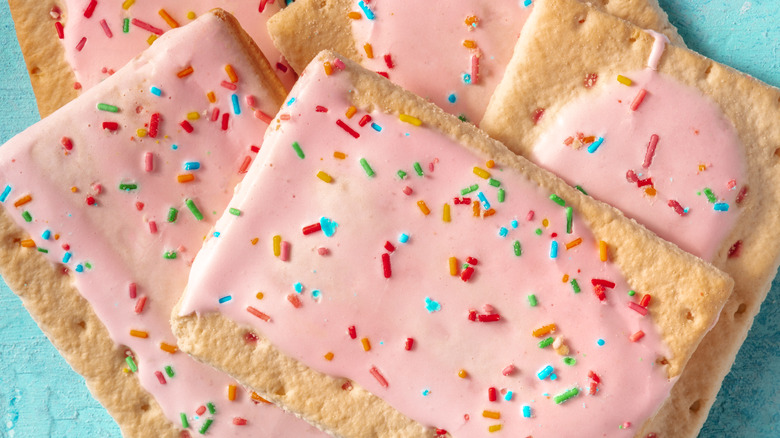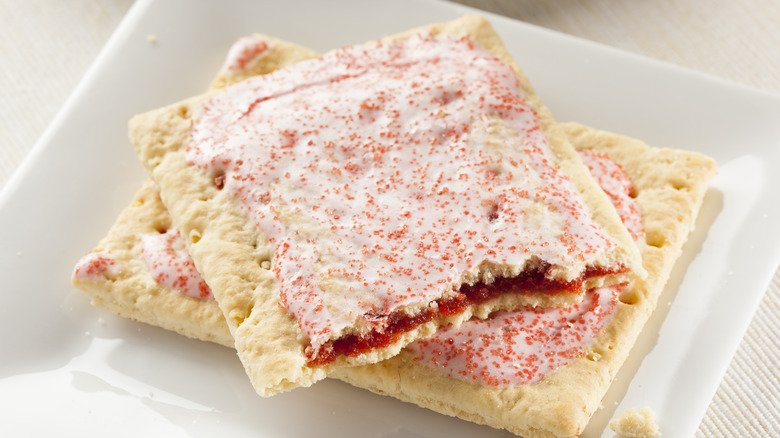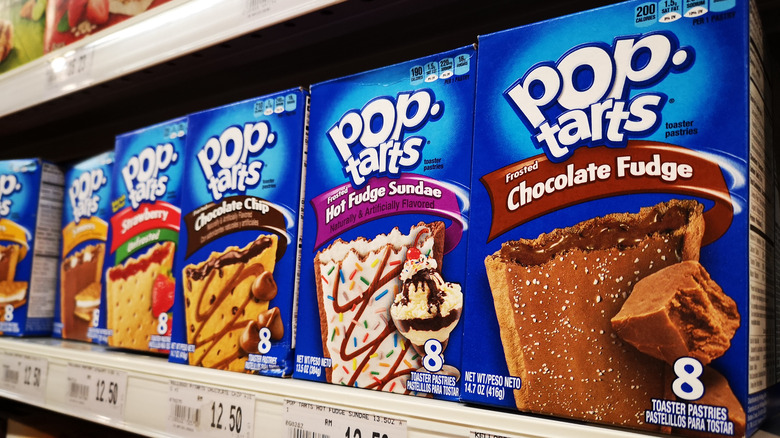Unfrosted Claims To Know Why Pop-Tarts Were Designed For The Toaster
Pop-Tarts — the iconic pocket toaster pastries that debuted in 1964 — have since their inception inspired a variety of flavor combinations, fanfare of all ages, and of course, a pretty famous debate surrounding the treat: "frosted or unfrosted?" But do you ever wonder exactly why they were designed for the toaster? Jerry Seinfeld's 2024 Netflix comedy, "Unfrosted," claims to provide the reason. In a fast-paced scene, Seinfeld's fictional Kellogg executive Bob Cabana and Melissa McCarthy's Donna Stankowski race against the timer to edge out their competitors with a game-changing hot pastry that merges convenience with taste. The reason given is simple. And it's an enthusiastic nod to product predecessors Chef Boyardee ravioli and the Schwinn bike that offers the "a-ha" moment which puts the final button on the invention of the Pop-Tart.
The reason for making it a toaster pastry comes down to the kids. "Maybe they can't handle an oven," Cabana says in the film, "but they can handle a toaster!" And with that, the toaster pastry simple enough for a kid to cook was born — assuming that's how it all played out. "Unfrosted," while highly entertaining, is also highly fictionalized, and according to other sources, the delightfully kismet-like brainstorm session in which the determination that a Pop-Tart should be as kid-friendly as a Schwinn bike may not have happened that way at all.
What we really know about the reason Pop-Tarts were made for the toaster
While creating a product kids can make easily in their toaster worked wonders for Pop-Tarts' popularity and expansion of the brand, there isn't really any public information indicating that it was an intentional marketing strategy. What we do know, however, is that Kellogg leaned into marketing this product as a kid-friendly treat in other ways. The Pop-Tart was introduced to the consumer public when extremely sweet, convenient-to-eat foods had a lot of momentum.
While the toaster pastry was initially sold in shopping malls, its popularity was maximized due to the emergence and success of color television, which allowed younger kids to see the grab-and-go breakfast item in full color, practically handing kid-friendly marketing opportunities to Kellogg on a silver platter. Advertisements were run during kids' shows such as "Yogi Bear" and "Woody Woodpecker," and Milton the Toaster, Pop-Tarts' smiley mascot was introduced, along with fun flavors and vibrant colors. But as far as creating the mega-popular product for the toaster, the Pop-Tart was created as an alternative to toast and jam, so it's only natural that this one-stop-shop treat be toaster poppable — the fact that the ease of preparation for kids created a total marketing win, of course, is a bonus.
The evolution of Pop-Tarts flavors
In its original iteration, the Pop-Tart only came in four basic, unfrosted flavors — strawberry, blueberry, brown-sugar cinnamon, and apple currant jelly. The latter was discontinued because, as the Pop-Tarts website quite cheekily explained, "no one has ever seen a currant." But it wasn't until 1967 that frosted Pop-Tarts debuted — due to the time spent creating a frosting that could withstand the heat of a toaster — and promptly changed the game. This allowed the company to introduce four new frosted flavors to an adoring public: Dutch Apple, Concord Grape, Raspberry, and a frosted version of Brown Sugar Cinnamon that would later become one of the most popular Pop-Tart flavors ever.
In the decades since, what was once a mere idea has expanded to feature over 20 Pop-Tart flavors — both frosted and unfrosted — including Hot Fudge Sundae, Frosted Strawberry Milkshake, Frosted Banana Bread, Watermelon, and even pretzel Pop-Tarts. There have also been various competitor versions of the quick snack, perhaps most notably Pillsbury's Toaster Strudel, which was invented in 1985. But can you really blame them for trying to mimic success?


